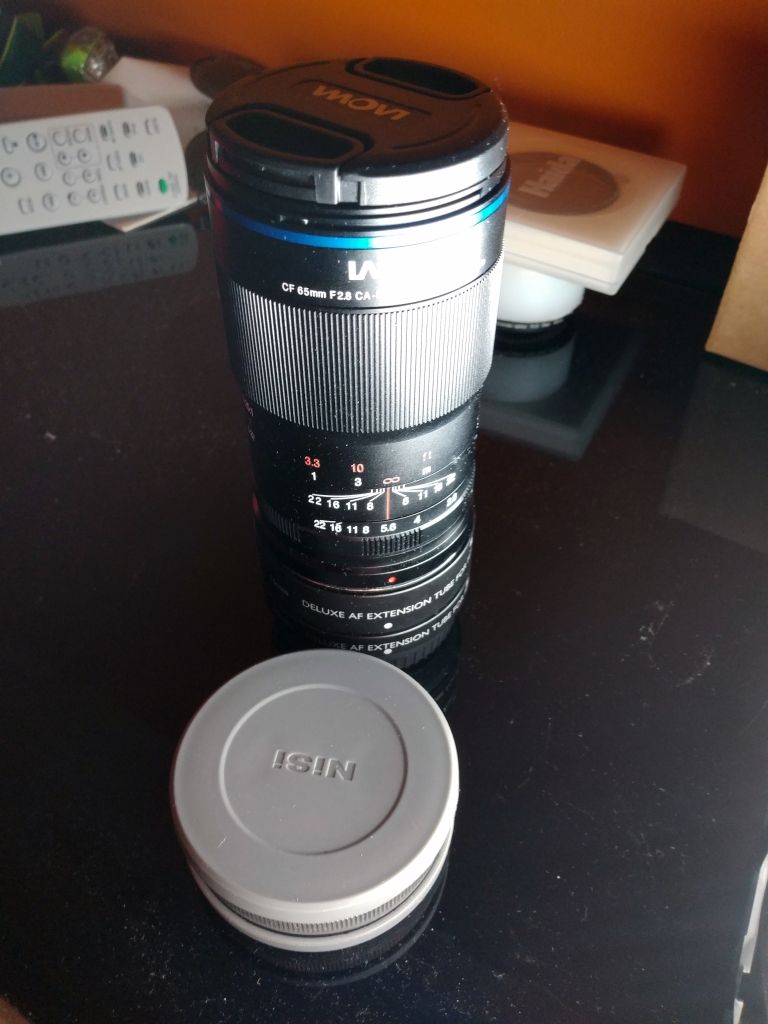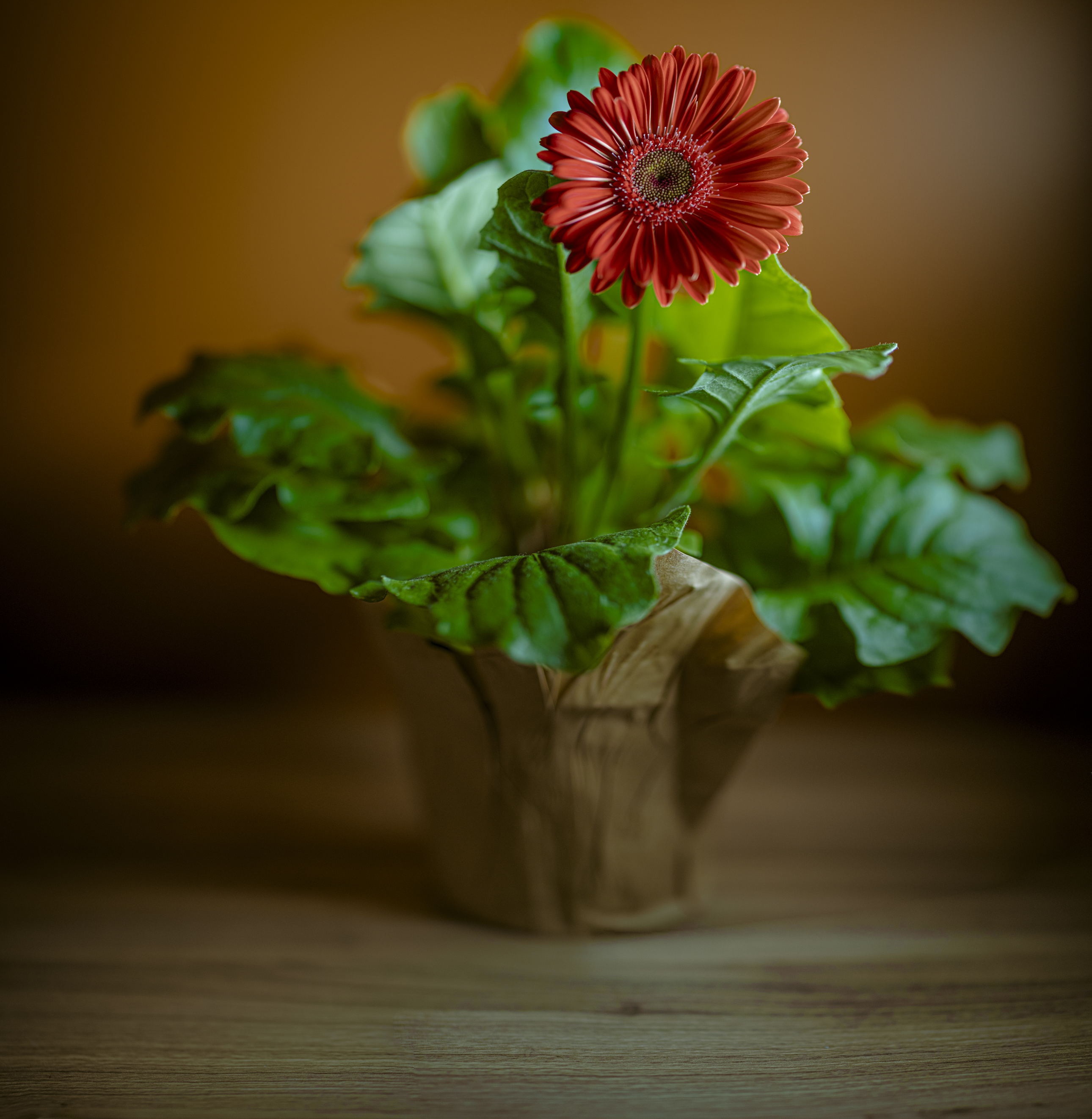
I used a third party Viltrox 23mm F/1.4 lens which was made for APS-C mirrorless Fuji X mount, to mount onto a Micro 4/3 Panasonic Lumix G95. For the time being, I had no ideal way of mounting the lens in reverse onto the camera, but I taped it to a set of extension tubes for as much magnification as I could possibly get. The Viltrox lens that was used is a high quality lens that initially cost me about $329; Part of the cost was due to the lens being capable of autofocus (AF). AF is something that I don’t need for this project; in fact, I likely shouldn’t be using an AF lens. As you can see from the image, the magnification was quite ample. Not only was there great magnification which could enable the camera to photograph an area about three millimeters by four millimeters across, but the image quality remained superb even though the lens isn’t mounted the “correct” way, and despite the extreme macro.
The high level of image quality is due to the lens being constructed of special lens elements that give it great sharpness, although there are prime lenses with about the same amount of focal length which are likely significantly greater with regard to optical resolution, and, such a lens which has been designed optically superior to the Viltrox, could be even greater and more capable when reversed. Keep in mind though, if you ever want the most magnification possible, you might want a slightly different lens; the Viltrox is a 23mm lens which has been designed to work optimally for APS-C mirrorless sensors. For Micro 4/3, the effective focal length is between 17mm and 18mm, when on the camera normally. I did some research about lenses to be able to find what lens configuration is best when reversed, to be able to get a maximum amount of magnification but without leading to an absurdly small working distance (minimum distance from the front lens element to subject); Ideally, it is best to use a lens which has been designated as about 10mm to 12mm for Micro 4/3 mount. Even without any extension tubes, such a wide-angle lens when mounted backwards onto a Micro 4/3 camera, is able to garner approximately 3X magnification! 10mm to 12mm is equivalent to a range of 20mm to 24mm for Full Frame.
I personally found it important to use such a wide focal length myself, although I don’t currently obtain such a lens; the reason being is that you can get a maximum amount of native magnification doing lens reversal this way; and something you might not be aware of, is that adding any extension tube to a lens can lead to some degradation of image quality if the lens’ isn’t optically built to a specific standard, mainly because the lens’ performance limit is therefore “stretched” by the use of extension. By starting out with greater native magnification, you don’t necessarily need to add as much extension to be able to achieve a given amount of magnification. Considering what I’ve tried before using a lens of my own mounted to extension tubes, you should be able to achieve a magnification of approximately 5X while maintaining a considerable amount of working distance; To achieve such a large magnification and be able to “zoom in” on things that could be extremely small to human vision but still be able to include lighting to the scene being photographed in a practical way, you can start by buying a 10mm or 12mm lens, and buying the appropriate Micro 4/3 reverse adapter/ring to see what the results are like after zero amount of extension. If the lens performance/optics hold up to the demands of your macro photography, then you may try increasing magnification by increasing the amount of extension in small increments. For example, try using a 10mm extension tube with the reversed lens, then add on a 16mm tube.
The more-or-less obvious aspect to consider is that if you want to practically maintain resolution or sharpness throughout the entire frame including the center throughout the midframe to the corners, you likely need to invest more money into the lens itself; the more expensive, the more quality. But, as I’ve already mentioned, AF isn’t something that should be included, so try looking for a lens that doesn’t have AF as it won’t work in reverse. What’s also important is that the lens doesn’t have optical image stabilization, as that isn’t useful to any extent when the lens is in reverse. What’s important for the lens characteristic to be inclusive though is that the lens be fully manual; look for a lens with fully manual aperture ring that can adjust aperture even when the lens isn’t mounted on a camera (important if the lens is in reverse).
Unfortunately, although the Viltrox lens had a manual aperture ring, it had to be pre-set while mounted onto a camera, which is something that beforehand I had not considered. Reverse lens technique is almost certainly the most effective macro technique for achieving the most magnification while staying within a rather small budget; this is the main reason why I decided to go with a reversed lens! While I don’t have the necessary component as of now, to be able to proprietarily mount the lens in reverse, I could optionally buy about four cheap adapters which I could make into an assembly and be able to mount onto the T-mount telescope adapter that I had, which could be mounted on the extension tubes that I obtained, whereas the T-mount adapter can act as an additional amount of extension; I’m not one hundred percent decided as of now as to whether that’s what I want to do, but I could certainly use some advice if anyone has any. The set of four adapters could cost me approximately forty dollars altogether, so it’s not an extremely expensive investment of a project.



 At one moment during the process of manipulation/post processing of the two photos in Photoshop, one being greatly underexposed while the other being greatly underexposed, I started to begin seeing a far more dramatic and aesthetic-looking composite start to take place, but unfortunately, I didn’t get far enough soon after that moment to make the composite look great without major flaws caused by using the brush tool during masking. I have wondered, is it even theoretically possible, to make such a photo using a single photo?! What came to mind while exploring in my mind such a dilemma, is how enormous the sensor might need to be to encapsulate the entire dynamic range required to bring to life enough details in both the astronomical sky as well as the meteorological foreground (clouds); made difficult by the mere fact that at the focal length of 162mm, which is the focal length at which the photo was taken, the clouds moved by extremely fast. Why have I chosen 162mm, if the lens can go to 230mm? Despite the fact that the lunar detail is much less visible at 162mm, there’s a wide field of view and in a sense much more room especially for much of the clouds’ structure to be visible. Some much more dramatic cloud forms might begin in the short future- perhaps?
At one moment during the process of manipulation/post processing of the two photos in Photoshop, one being greatly underexposed while the other being greatly underexposed, I started to begin seeing a far more dramatic and aesthetic-looking composite start to take place, but unfortunately, I didn’t get far enough soon after that moment to make the composite look great without major flaws caused by using the brush tool during masking. I have wondered, is it even theoretically possible, to make such a photo using a single photo?! What came to mind while exploring in my mind such a dilemma, is how enormous the sensor might need to be to encapsulate the entire dynamic range required to bring to life enough details in both the astronomical sky as well as the meteorological foreground (clouds); made difficult by the mere fact that at the focal length of 162mm, which is the focal length at which the photo was taken, the clouds moved by extremely fast. Why have I chosen 162mm, if the lens can go to 230mm? Despite the fact that the lunar detail is much less visible at 162mm, there’s a wide field of view and in a sense much more room especially for much of the clouds’ structure to be visible. Some much more dramatic cloud forms might begin in the short future- perhaps?